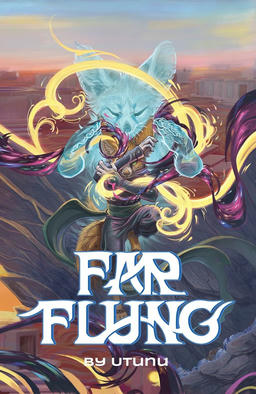Utunu’s science fiction tale dazzles with its world-building, although it’s more slice of life interlaced with charming romance than epic adventure.
Review: Far Flung
Arilin Thorferra
I’ve had “read something by Utunu” on my list for a while now. When his ebooks became available on Bad Dog Books recently, I picked up his most recent novel, Far Flung. This YA-slanted science fiction novel—also a gay romance—won the Cóyotl Award for best novel in 2024.
It’s not hard to see how Far Flung won that award: the world-building is absolutely extraordinary. It takes place in Oasis, the solitary settlement of an otherwise barren, desert-like world in a system that has multiple planets that can support life. Fennecs and hyenas stranded long ago when a generation ship crashed now make a modest living, trading when they can with Verdant, another, more readily habitable planet in the system that other survivors migrated to via a salvaged shuttlecraft. Some fennecs have psionic talent—in some cases, the ability to teleport short distances, bringing others with them, and in rare cases the ability to “Fling” fantastically long distances. This talent enabled their space travel and, indeed, much of the technology they’re slowly losing.
The story focuses on two fennecs, the young psionic Bori and his supposedly non-psionic friend Tuther, along with their hyena friend Samna. We quickly learn that Bori has extremely powerful Flinging ability, and Tuther is a quite powerful psionic in his own right. He can’t teleport—but he can Hide his own ability, as well as masking just how powerful Bori is. Bori doesn’t want his ability fully recognized; if it , he’ll almost certainly be chosen by the settlers on Verdant to be taken back with them and separated from his partners.
The characterization is as vivid as the milieu. Not just the main trio but all the side characters feel alive, distinct, and well-drawn. This is a great slice-of-life story about lives in a setting unlike anything else—the worlds of Sands and Verdant certainly evoke other science fiction worlds, but they stand alone. The mind-to-mind dialog is also represented in a way unlike anything I’ve seen before, enough to make me forgive the use of an exotic secondary typeface. (If you’re reading the ebook, you’ll want to present it in the original font, not override it with a theme.)
For all of that, the story’s pitch promises more than slice of life: there’s so much dread around Bori being taken to Verdant. Are the settlers on Verdant despots who abduct their poorer relations for nefarious purposes? Will Bori be in mortal danger? Will the three be separated, with Samna and Tuther having to orchestrate a daring interplanetary rescue? This is, unfortunately, where Far Flung doesn’t fling quite far enough. Problems are quickly resolved, fears are allayed, everyone is cooperative and accepting. Every possible point of tension along the way is effectively met with a that went quite well, didn’t it.
But then, there’s those last four chapters. A character takes a heel turn, dramatic action happens, and yes, everyone’s lives are changed forever. While it’s not that this ending doesn’t work, until this pivot, Far Flung seemed destined for the kind of cozy ending that Fairy Tales had.
Here, I should note that “not a cozy ending” is not a coy way of saying “sad ending”; taken as a young romance, the story is more than fulfilling. Even though there’s little to propel you along through much of the book beyond wanting to spend time with the characters, there’s a very good chance you will want to spend time with them, and that might be more than enough. Also, that sharp left turn of an ending promises not only a sequel but one that, I suspect, brings bigger stakes and greater tension with it.
